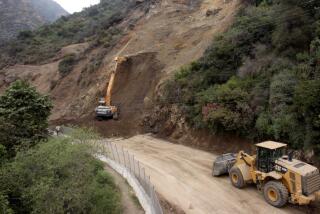Difficult Link : First Section of East-West Route 56 a Long Time in Coming
Here is a look at what is involved in laying the first 1.9 miles of the controversial 9-mile State Route 56. From conception to its tentative completion in March, 1993, it will have taken a little more than 27 years for these first couple of miles to be laid. It remains uncertain when the rest of the route will be built.
How did the plan to build State Route 56 get started?
In 1965, a group of transportation planners envisioned a mid-point route connecting North County from east to west.
The Route 56 plan ultimately adopted calls for linking the coastal communities of Del Mar, La Jolla and Carmel Valley (North City West) with the I-15 corridor communities of Penasquitos East, Carmel Mountain Ranch and Poway.
The route would lessen congestion on Del Dios Highway and Mira Mesa Boulevard as well as reduce the number of trips on Route 52 and California 78.
The California Department of Transportation estimates that traffic on the completed route would be about 152,000 trips per day.
Why the delay in getting the project going?
There have been a variety of reasons for the delays. For a number of years, state officials were intent on upgrading existing freeways, not building new ones. There have been funding problems and numerous public hearings relating to the environmental implications of building the freeway--including impact on residential development, wildlife and plant life.
Controversies and litigation continue to surround the central and west portions of the project.
When did construction start?
On July 29, construction began on the east portion, a 1.9-mile section running from Black Mountain Road to I-15 at Rancho Penasquitos Boulevard.
Caltrans expects to begin construction on the 2-mile west section in August, 1992. Objections to that part of the project have been raised by the Carmel Valley Coalition, a homeowners’ group, the Sierra Club, and the Del Mar Terrace Conservancy, a watchdog group primarily interested in preserving coastal wetlands. The conservancy plans to appeal a February court decision that supports allowing the project to go forward.
There is no timetable for construction on the central section, according to Caltrans attorney Jeffrey Joseph. Development in the area is restricted to a density of one unit per 10 acres. A citywide vote is required to develop it further.
What is the design?
The east end will be a four-lane freeway, with two auxiliary lanes between Black Mountain Road and Rancho Penasquitos Boulevard. In four places, existing roads will pass under the new freeway.
For the foreseeable future, its use will be limited to local traffic.
How is the project being funded?
Funds are coming from the 1/2-cent sales tax that voters passed under Proposition A in 1987. The east-end portion will cost about $12.5 million, said Paul Hardin, a project engineer for the Caltrans and one of the designers of the freeway. The price tag for all nine miles of Route 56 is estimated at $42.1 million.
What about the environmental impact?
Environmental specialists conducted the nine separate studies that are always done before a freeway is built. The studies examine, among other things, the freeway’s appearance and impact on the area’s biology, archeology, air standards and noise levels.
California Blacktail Gnatcatchers, who make their home in the area, had to be moved before construction began. Caltrans purchased 29 acres near Blue Sky Ranch, an ecological preserve in Poway, and relocated the birds there.
Fifty barrel cacti, a plant on the endangered list, are being transplanted, said Agnes Weber, Caltrans engineer on the east-end project. The cacti have been incorporated into the project and motorists will be able to see them along the sides of the road.
During the digging, workers did not unearth significant archeological artifacts to delay construction, said Hardin.
No homes or buildings on the east end had to be displaced because the freeway alignment went between neighborhoods.
To help soften the impact of freeway noise on homes, three sound berms, huge mounds of earth placed to deaden the noise, were added, Hardin said. A sound wall has also been built on the north side of the project between Rancho Penasquitos Boulevard and Salmon River Road, said Weber.
Who is doing the construction work?
Construction of the east-end project was awarded jointly to the contracting firms of Daley Corp. and W.R. Connelly, after being advertised in December.
Caltrans has seven people to oversee construction, said Weber. The two main contractors have employed eight subcontractors, said John Nelson, vice president of construction for Daley Corp.
What are they working on now?
Crews are working on grading, bridges, drainage and sewers.
Earth movers are being used to level out the hills and valleys to create a relatively flat grade for the roadway. When the east end is finished, the dirt crew will have dug up more than 1.1 million cubic yards of dirt and put it back into the project, some in the form of embankments and sound berms.
By the time the pavement is laid, bridge crews will have used 6,000 cubic yards of concrete, and the concrete crews will have laid 12,600 cubic yards of pavement, Nelson said.
More to Read
Sign up for Essential California
The most important California stories and recommendations in your inbox every morning.
You may occasionally receive promotional content from the Los Angeles Times.









